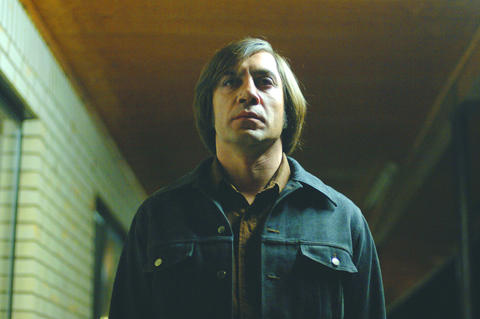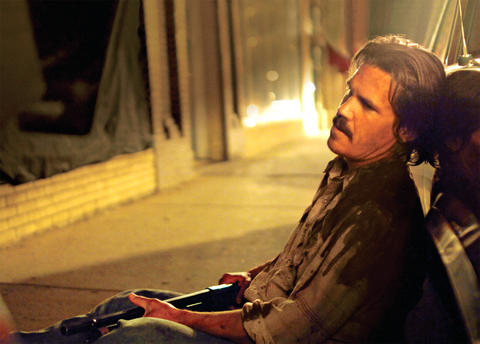No Country for Old Men, adapted by Joel and Ethan Coen from Cormac McCarthy's novel, is bleak, scary and relentlessly violent. At its center is a figure of evil so calm, so extreme, so implacable that to hear his voice is to feel the temperature in the theater drop.
But while that chilly sensation is a sign of terror, it may equally be a symptom of delight. The specter of Anton Chigurh (Javier Bardem), a deadpan sociopath with a funny haircut, will feed many a nightmare, but the most lasting impression left by this film is likely to be the deep satisfaction that comes from witnessing the nearly perfect execution of a difficult task. No Country for Old Men is purgatory for the squeamish and the easily spooked. For formalists - those moviegoers sent into raptures by tight editing, nimble camera work and faultless sound design - it's pure heaven.
So before I go any further, allow me my moment of bliss at the sheer brilliance of the Coens' technique. And it is mostly theirs. The editor, Roderick Jaynes, is their long-standing pseudonym. Cinematographer Roger Deakins and composer Carter Burwell are collaborators of such long standing that they surely count as part of the non-biological Coen fraternity. At their best, and for that matter at their less than best, Joel and Ethan Coen, who share writing and directing credit here, combine virtuosic dexterity with mischievous high spirits, as if they were playing Franz Liszt's most treacherous compositions on dueling banjos. Sometimes their appetite for pastiche overwhelms their more sober storytelling instincts, so it is something of a relief to find nothing especially showy or gimmicky in No Country. In the Coen canon it belongs with Blood Simple, Miller's Crossing and Fargo as a densely woven crime story made more effective by a certain controlled stylistic perversity.

PHOTOS: AP AND COURTESY OF UIP
The script follows McCarthy's novel almost scene for scene, and what the camera discloses is pretty much what the book describes: a parched, empty landscape; pickup trucks and taciturn men; and lots of killing. But the pacing, the mood and the attention to detail are breathtaking, sometimes literally.
In one scene a man sits in a dark hotel room as his pursuer walks down the corridor outside. You hear the creak of floorboards and the beeping of a transponder, and see the shadows of the hunter's feet in the sliver of light under the door. The footsteps move away, and the next sound is the faint squeak of the light bulb in the hall being unscrewed. The silence and the slowness awaken your senses and quiet your breathing, as by the simplest cinematic means - Look! Listen! Hush! - your attention is completely and ecstatically absorbed. You won't believe what happens next, even though you know it's coming.
By the time this moment arrives, though, you have already been pulled into a seamlessly imagined and self-sufficient reality. The Coens have always used familiar elements of American pop culture and features of particular American landscapes to create elaborate and hermetic worlds. McCarthy, especially in the western phase of his career, has frequently done the same. The surprise of No Country for Old Men, the first literary adaptation these filmmakers have attempted, is how well matched their methods turn out to be with the novelist's.

PHOTOS: AP AND COURTESY OF UIP
McCarthy's book, for all its usual high-literary trappings (many philosophical digressions, no quotation marks), is one of his pulpier efforts, as well as one of his funniest. The Coens, seizing on the novel's genre elements, lower the metaphysical temperature and amplify the material's dark, rueful humor. It helps that the three lead actors - Tommy Lee Jones and Josh Brolin along with Bardem - are adept at displaying their natural wit even when their characters find themselves in serious trouble.
The three are locked in a swerving, round-robin chase that takes them through the empty ranges and lonely motels of the West Texas border country in 1980. The three men occupy the screen one at a time, almost never appearing in the frame together, even as their fates become ever more intimately entwined.
Jones plays Ed Tom Bell, a world-weary third-generation sheriff whose stoicism can barely mask his dismay at the tide of evil seeping into the world. Whether Chigurh is a magnetic force moving that tide or just a particularly nasty specimen carried in on it is one of the questions the film occasionally poses. The man who knows him best, a dandyish bounty hunter played by Woody Harrelson, describes Chigurh as lacking a sense of humor. But the smile that rides up one side of Chigurh's mouth as he speaks suggests a diabolical kind of mirth - just as the haircut suggests a lost Beatle from hell - and his conversation has a teasing, riddling quality. The punch line comes when he blows a hole in your head with the pneumatic device he prefers to a conventional firearm.
And the butt of his longest joke is Llewelyn Moss (Brolin), a welder who lives in a trailer with his wife, Carla Jean (Kelly MacDonald) and is dumb enough to think he's smart enough to get away with taking the US$2 million he finds at the scene of a drug deal gone bad. Chigurh is charged with recovering the cash (by whom is neither clear nor especially relevant), and poor Sheriff Bell trails behind, surveying scenes of mayhem and trying to figure out where the next one will be.
Taken together, these three hombres are not quite the Good, the Bad and the Ugly, but each man does carry some allegorical baggage. Jones' craggy, vinegary warmth is well suited to the kind of righteous, decent lawman he has lately taken to portraying. Ed Tom Bell is almost continuous with the retired MP Jones played in Paul Haggis' In the Valley of Elah. It is hard to do wisdom without pomposity, or probity without preening, but Jones manages with an aplomb that is downright thrilling.
Still, if No Country for Old Men were a simple face-off between the sheriff's goodness and Chigurh's undiluted evil, it would be a far stiffer, less entertaining picture. Llewelyn is the wild card - a good old boy who lives on the borderline between good luck and bad, between outlaw and solid citizen - and Brolin is the human center of the movie, the guy you root for and identify with even as the odds against him grow steeper by the minute.
And the minutes fly by, leaving behind some unsettling notions about the bloody, absurd intransigence of fate and the noble futility of human efforts to master it. Mostly, though, No Country for Old Men leaves behind the jangled, stunned sensation of having witnessed a ruthless application of craft.

May 26 to June 1 When the Qing Dynasty first took control over many parts of Taiwan in 1684, it roughly continued the Kingdom of Tungning’s administrative borders (see below), setting up one prefecture and three counties. The actual area of control covered today’s Chiayi, Tainan and Kaohsiung. The administrative center was in Taiwan Prefecture, in today’s Tainan. But as Han settlement expanded and due to rebellions and other international incidents, the administrative units became more complex. By the time Taiwan became a province of the Qing in 1887, there were three prefectures, eleven counties, three subprefectures and one directly-administered prefecture, with

President William Lai (賴清德) yesterday delivered an address marking the first anniversary of his presidency. In the speech, Lai affirmed Taiwan’s global role in technology, trade and security. He announced economic and national security initiatives, and emphasized democratic values and cross-party cooperation. The following is the full text of his speech: Yesterday, outside of Beida Elementary School in New Taipei City’s Sanxia District (三峽), there was a major traffic accident that, sadly, claimed several lives and resulted in multiple injuries. The Executive Yuan immediately formed a task force, and last night I personally visited the victims in hospital. Central government agencies and the

Among Thailand’s Chinese Nationalist Party (KMT) villages, a certain rivalry exists between Arunothai, the largest of these villages, and Mae Salong, which is currently the most prosperous. Historically, the rivalry stems from a split in KMT military factions in the early 1960s, which divided command and opium territories after Chiang Kai-shek (蔣介石) cut off open support in 1961 due to international pressure (see part two, “The KMT opium lords of the Golden Triangle,” on May 20). But today this rivalry manifests as a different kind of split, with Arunothai leading a pro-China faction and Mae Salong staunchly aligned to Taiwan.

As with most of northern Thailand’s Chinese Nationalist Party (KMT) settlements, the village of Arunothai was only given a Thai name once the Thai government began in the 1970s to assert control over the border region and initiate a decades-long process of political integration. The village’s original name, bestowed by its Yunnanese founders when they first settled the valley in the late 1960s, was a Chinese name, Dagudi (大谷地), which literally translates as “a place for threshing rice.” At that time, these village founders did not know how permanent their settlement would be. Most of Arunothai’s first generation were soldiers